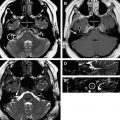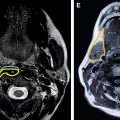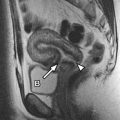New developments in musculoskeletal magnetic resonance (MR) imaging, including improved spatial resolution and MR arthrography, have led to an increasing frequency in the performance of shoulder MR imaging. As a result, radiologists’ understanding of the normal and variant anatomy of the shoulder visible on MR imaging has also become more important. In this article, the authors review the normal arrangement and appearance of osseous and soft-tissue structures in the shoulder, as well as nonpathologic osseous and nonosseous variants that should be recognized.
New developments in musculoskeletal magnetic resonance (MR) imaging, including improved spatial resolution and MR arthrography, have led to an increasing frequency in the performance of shoulder MR imaging. As a result, radiologists’ understanding of the normal and variant anatomy of the shoulder visible on MR imaging has also become more important. In this article, the authors review the normal arrangement and appearance of osseous and soft-tissue structures in the shoulder, as well as nonpathologic osseous and nonosseous variants that should be recognized.
Protocols
When imaging the shoulder with MR imaging, patients are placed in a supine position with their arm on the side of the body in partial external rotation. Initially, the localizer images are obtained, followed by coronal-oblique, sagittal-oblique, and axial images. The coronal-oblique plane is selected parallel to the course of the supraspinatus tendon. Because the supraspinatus tendon may have a degree of obliquity that is different than the supraspinatus muscle, it is important to select the course of the tendon itself when prescribing the coronal-oblique plane for optimal visualization of the tendon. The sagittal-oblique images are prescribed parallel to the glenoid surface. Typical sequences obtained at the authors’ institution are listed in Table 1 .
| Pulse Sequence | FOV (cm) | Slice Thickness (mm) | Matrix | TR/TE |
|---|---|---|---|---|
| Axial T2 fat saturation | 14 | 4 | 256 × 256 | 3500/45 |
| Coronal oblique T1 | 14 | 4 | 256 × 256 | 560–615/11–14 |
| Coronal oblique T2 with fat saturation | 14 | 4 | 256 × 256 | 3500/50–54 |
| Sagittal oblique T1 | 14 | 4 | 256 × 256 | 518–628/10–12 |
| Sagittal oblique T2 with fat saturation | 14 | 4 | 256 × 256 | 3500/45 |
Normal osseous structures
The osseous shoulder is comprised of the proximal humerus, scapula, and clavicle. Multiple components of the scapula contribute to the shoulder, including the glenoid, coracoid process, and acromion. The glenohumeral joint forms what is conventionally thought of as the shoulder joint, whereas the articulation of the other scapular components with the clavicle and the humerus gives the joint added stability and range of motion. In this section, the authors discuss the normal anatomy of the 3 bones that make up the shoulder.
Proximal Humerus
The proximal humerus consists of the humeral head, the greater and lesser tuberosities, the humeral neck, and the bicipital groove. The humeral head makes the most significant contribution to the shoulder. It is typically round, with slight flattening of the posteroinferior surface. This slight flattening should not be confused with a Hill-Sachs lesion as a sequela of anterior shoulder dislocation, which is seen at or above the level of the coracoid process ( Fig. 1 ). The central portion of the humeral head is spherical, whereas the peripheral contour is more elliptical. The morphology of the humeral head varies somewhat between men and women, particularly with respect to the radius of curvature, which is larger in men than women. Distinction is commonly made between the anatomic and the surgical necks of the humerus. The anatomic neck forms the oblique circumference of the humeral head and separates the head from the tuberosities. The surgical neck forms the axial circumference of the humerus immediately inferior to the tuberosities and is often involved in fractures. The cartilage overlying the humeral head is only approximately 1 mm thick. Subchondral cysts can be present within the humeral head and are normally found at the insertions of the supraspinatus and infraspinatus tendons. The cysts in these locations do not represent degenerative sequelae, whereas cysts located more anteriorly are associated with subscapularis tendon pathology.
The bicipital groove, also known as intertubercular groove, runs between the greater and lesser tuberosities and supports the long head of the biceps tendon. The transverse humeral ligament crosses the long head of the biceps tendon perpendicular to the bicipital groove. The width and depth of the groove both affect the risk of subluxation of the long head of the biceps tendon. A shallow bicipital groove predisposes to dislocation of the long head of the biceps tendon.
Scapula
The scapula is composed of a spine, neck, and body, as well as the acromion, coracoid process, and glenoid. The latter three structures form articulations with the humeral head and the clavicle to become components of the shoulder joint.
The acromion is a posterior shoulder landmark, formed as a posterolateral extension of the scapular spine, superior to the glenoid. It articulates with the clavicle and is the origin of the deltoid and trapezius muscles. The shape of the acromion is symmetric bilaterally but can vary with gender. Bigliani and colleagues’ classification system for acromial morphology offers three types: I (flat), II (curved), and III (hooked) ( Fig. 2 ). It is hypothesized that the hooked acromion is in fact an acquired form and increases an individual’s predisposition to rotator cuff pathology.
The coracoid process is an anterior shoulder landmark, arising from the anterolateral aspect of the scapula, superior and medial to the glenoid fossa. It also represents the tendinous origins of a number of upper extremity and chest wall muscles, including the pectoralis minor and long head of the biceps brachii. The morphology of the coracoid is extremely variable.
The glenoid articulates with the medial aspect of the humeral head to form the shoulder joint. The glenoid is pear shaped (also known as inverted-comma shaped) or oval shaped in the coronal plane and does not vary appreciably in size between men and women; significant differences in glenoid morphology have been found among different ethnicities. The glenoid cavity is retroverted by approximately 5° to 7°. The postero-inferior rim of the glenoid can have various shapes, including triangular, J shaped, and deltoid. The latter two are associated with varying degrees of posterior shoulder instability ( Fig. 3 ), as is loss of tilting and concavity of the inferior glenoid. At the superior aspect of the glenoid, the supraglenoid tubercle serves as the attachment for the long head of the biceps.
Clavicle
The clavicle is an S-shaped bone that forms the sternoclavicular joint medially and the acromioclavicular joint laterally. Its morphology is extremely variable, ranging from flat to sharply curved. Increased thickness and curvature is seen in manual workers, and the right clavicle is often stronger than the left.
Normal osseous structures
The osseous shoulder is comprised of the proximal humerus, scapula, and clavicle. Multiple components of the scapula contribute to the shoulder, including the glenoid, coracoid process, and acromion. The glenohumeral joint forms what is conventionally thought of as the shoulder joint, whereas the articulation of the other scapular components with the clavicle and the humerus gives the joint added stability and range of motion. In this section, the authors discuss the normal anatomy of the 3 bones that make up the shoulder.
Proximal Humerus
The proximal humerus consists of the humeral head, the greater and lesser tuberosities, the humeral neck, and the bicipital groove. The humeral head makes the most significant contribution to the shoulder. It is typically round, with slight flattening of the posteroinferior surface. This slight flattening should not be confused with a Hill-Sachs lesion as a sequela of anterior shoulder dislocation, which is seen at or above the level of the coracoid process ( Fig. 1 ). The central portion of the humeral head is spherical, whereas the peripheral contour is more elliptical. The morphology of the humeral head varies somewhat between men and women, particularly with respect to the radius of curvature, which is larger in men than women. Distinction is commonly made between the anatomic and the surgical necks of the humerus. The anatomic neck forms the oblique circumference of the humeral head and separates the head from the tuberosities. The surgical neck forms the axial circumference of the humerus immediately inferior to the tuberosities and is often involved in fractures. The cartilage overlying the humeral head is only approximately 1 mm thick. Subchondral cysts can be present within the humeral head and are normally found at the insertions of the supraspinatus and infraspinatus tendons. The cysts in these locations do not represent degenerative sequelae, whereas cysts located more anteriorly are associated with subscapularis tendon pathology.
The bicipital groove, also known as intertubercular groove, runs between the greater and lesser tuberosities and supports the long head of the biceps tendon. The transverse humeral ligament crosses the long head of the biceps tendon perpendicular to the bicipital groove. The width and depth of the groove both affect the risk of subluxation of the long head of the biceps tendon. A shallow bicipital groove predisposes to dislocation of the long head of the biceps tendon.
Scapula
The scapula is composed of a spine, neck, and body, as well as the acromion, coracoid process, and glenoid. The latter three structures form articulations with the humeral head and the clavicle to become components of the shoulder joint.
The acromion is a posterior shoulder landmark, formed as a posterolateral extension of the scapular spine, superior to the glenoid. It articulates with the clavicle and is the origin of the deltoid and trapezius muscles. The shape of the acromion is symmetric bilaterally but can vary with gender. Bigliani and colleagues’ classification system for acromial morphology offers three types: I (flat), II (curved), and III (hooked) ( Fig. 2 ). It is hypothesized that the hooked acromion is in fact an acquired form and increases an individual’s predisposition to rotator cuff pathology.
The coracoid process is an anterior shoulder landmark, arising from the anterolateral aspect of the scapula, superior and medial to the glenoid fossa. It also represents the tendinous origins of a number of upper extremity and chest wall muscles, including the pectoralis minor and long head of the biceps brachii. The morphology of the coracoid is extremely variable.
The glenoid articulates with the medial aspect of the humeral head to form the shoulder joint. The glenoid is pear shaped (also known as inverted-comma shaped) or oval shaped in the coronal plane and does not vary appreciably in size between men and women; significant differences in glenoid morphology have been found among different ethnicities. The glenoid cavity is retroverted by approximately 5° to 7°. The postero-inferior rim of the glenoid can have various shapes, including triangular, J shaped, and deltoid. The latter two are associated with varying degrees of posterior shoulder instability ( Fig. 3 ), as is loss of tilting and concavity of the inferior glenoid. At the superior aspect of the glenoid, the supraglenoid tubercle serves as the attachment for the long head of the biceps.
Clavicle
The clavicle is an S-shaped bone that forms the sternoclavicular joint medially and the acromioclavicular joint laterally. Its morphology is extremely variable, ranging from flat to sharply curved. Increased thickness and curvature is seen in manual workers, and the right clavicle is often stronger than the left.
Normal soft-tissue structures
Several muscles, tendons, ligaments, and cartilaginous structures work in synchrony to move and support the shoulder. The normal MR imaging appearance of these structures is important to recognize in an effort to identify associated pathology.
Rotator Cuff
The rotator cuff allows for range of motion at the shoulder and protects and stabilizes the glenohumeral joint. Four muscles comprise the rotator cuff: the supraspinatus, infraspinatus, teres minor, and subscapularis. The four fan-shaped muscles all arise from the scapula and attach to the humerus, with the subscapularis inserting on the lesser tuberosity and the other three muscles inserting on the greater tuberosity. The subscapularis lies anterior to the scapular body, whereas the supraspinatus, infraspinatus, and teres minor lie posteriorly in order from superior to inferior. The insertion pattern of the rotator cuff tendons is consistent across individuals, with the tendons arranged in a horseshoe-shaped configuration about the humeral head. The subscapularis tendon is the most anterior, followed by the supraspinatus tendon at the superior aspect of the humeral head, and the infraspinatus and teres minor tendons posteriorly ( Fig. 4 ).
The supraspinatus muscle arises from the supraspinous fossa along the dorsal scapula and is innervated by the suprascapular nerve. Its tendon passes inferior to the clavicle and inserts on the greater tuberosity of the humerus. The supraspinatus is required for normal lateral abduction of the upper extremity. The infraspinatus muscle arises from the infraspinous fossa along the dorsal scapula and is also innervated by the suprascapular nerve. Its tendon also inserts on the greater tuberosity. The infraspinatus allows for external rotation and posterior abduction of the upper extremity. The teres minor muscle arises from the dorsolateral scapula and is innervated by the axillary nerve. Its tendon unites with the posterior inferior aspect of the capsule and inserts on and just inferior to the greater tuberosity. Along with the infraspinatus, the teres minor assists in external rotation of the shoulder. Some fibers of the teres minor can fuse with those of the infraspinatus. The subscapularis arises from the subscapular fossa of the ventral scapula and is innervated by the subscapular nerves. Its tendon runs along the subscapular bursa and inserts on the lesser tuberosity. The subscapularis is responsible for internal rotation of the shoulder, as well as anterior abduction of the humerus (see Fig. 4 ; Figs. 5 and 6 ).








